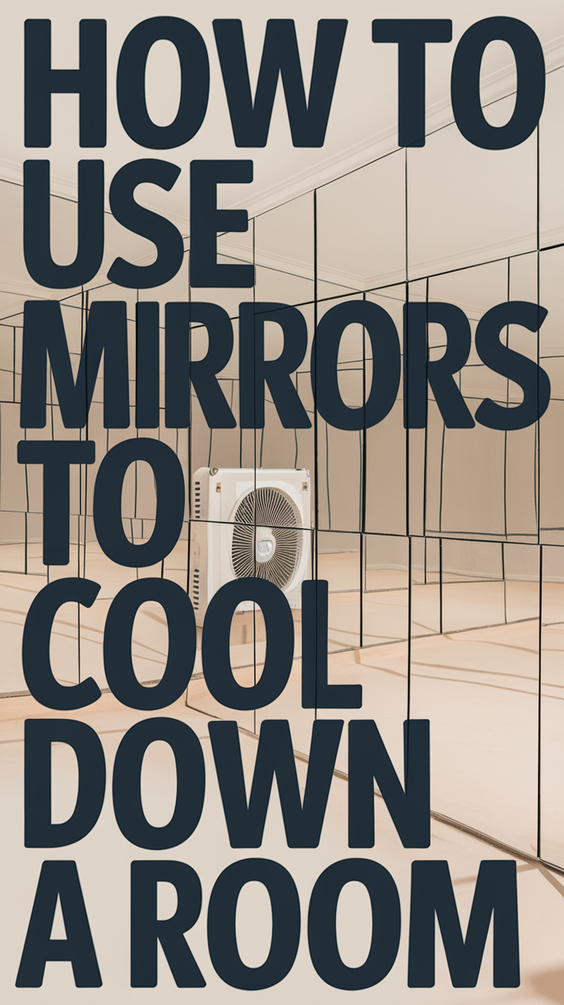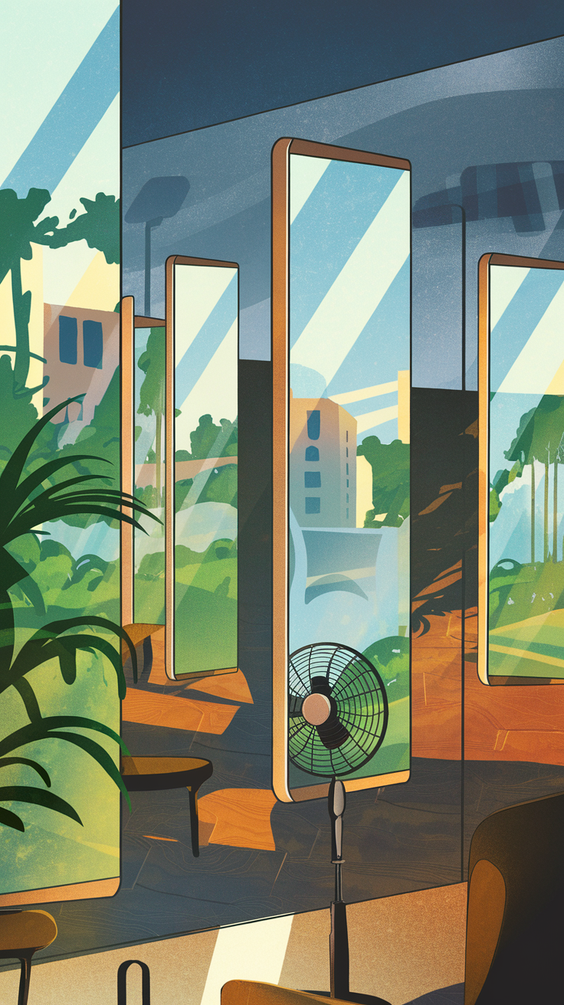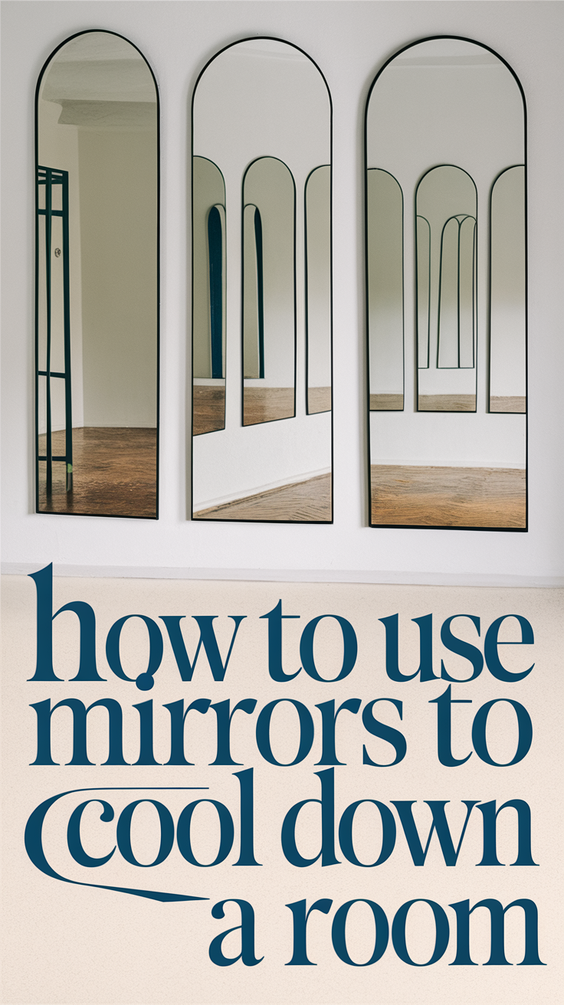How to Use Mirrors to Cool Down a Room
Did You Know Mirrors Can Help Cool Your Room in Summer 2025?
You’re probably used to thinking of mirrors as tools for makeup, outfits, or making your space feel larger. But what if they could also make your room feel noticeably cooler?
As global temperatures continue to climb in 2025, especially during peak summer months, homeowners and renters alike are searching for cost-effective, eco-friendly cooling solutions. And here’s the surprising part: mirrors—yes, your everyday home accessory—can actually help lower the temperature of a room when used strategically.
In this guide, we’ll show you how to use mirrors to cool down a room, where to place them, what types are most effective, and how to combine them with other cooling methods. Whether you’re living in a sun-soaked apartment, a suburban house, or designing an energy-efficient space, this article is for you.
How Mirrors Affect Room Temperature and Light
Reflecting Light, Not Heat
Mirrors don’t generate cold—but they do influence how light and heat interact with your room. Sunlight entering through a window heats up the surfaces it touches. If that light hits dark furniture or walls, the heat is absorbed. But when a mirror is placed correctly, it reflects the light back out or away, preventing that absorption.
This reflection, when managed properly, can keep direct sunlight from overheating your interior.
Redirecting Thermal Energy
While mirrors don’t block infrared radiation (the part responsible for heat) entirely, they do redirect it. This can be useful when paired with window treatments, cool-colored walls, or shaded zones.
💡 Did you know? Rooms with properly placed mirrors and light-toned decor can feel up to 3°F (1.5°C) cooler in mid-summer sun.
Where to Place Mirrors for a Cooling Effect
Avoid Direct Sunlight
It may seem smart to put mirrors right across from windows, but this can actually amplify heat in the room. Instead, place mirrors at an angle where they reflect light toward a darker, cooler part of the room—or ideally, redirect it back outside through another window or onto a shaded floor.
Use North-Facing Walls
Mirrors on north-facing walls rarely catch direct sun. They reflect diffused light and enhance brightness without raising the temperature.
Create a Vertical Path for Light Flow
By positioning mirrors vertically (like in tall hallway corners), you can help bounce light upward—where it’s less likely to heat up furniture or floors. This makes a space feel bright and airy without increasing thermal load.
Pairing Mirrors with Cooling Textiles and Shades
Mirrors on their own are helpful, but pairing them with thermal curtains or UV-reflective shades makes them even more effective.
-
Thermal curtains block heat entry.
-
Mirrors bounce light into shaded corners, maintaining brightness without direct sun.
-
Result: a cooler room that still feels open and naturally lit.
🎯 Pro Tip: Use mirrors behind sheer curtains to reflect filtered sunlight—soft illumination without added heat.
What Mirror Types Are Best for Cooling?
Here’s a quick comparison:
| Mirror Type | Heat Reflection | Best Use Case |
|---|---|---|
| Clear Wall Mirrors | Medium | Living rooms, hallways |
| Tinted/UV-Coated Mirrors | High | Near sunny windows |
| Matte/Satin Mirrors | Low | Aesthetic use, not for cooling |
| Reflective Films (on glass) | High | Window panes, balcony doors |
Mirrors with UV-blocking coatings are particularly helpful in hot climates like Arizona, Nevada, or Southern California. They can reflect both light and some heat radiation.
Common Mistakes to Avoid
Even with the best intentions, it’s easy to misuse mirrors. Watch out for these:
-
❌ Facing mirrors directly toward sunlit windows – can reflect and trap heat inside.
-
❌ Using mirrors over dark, heat-absorbent furniture – increases localized warmth.
-
❌ Overloading small spaces with mirrors – creates glare and discomfort instead of relief.
Ask yourself: Is this mirror reflecting light into a shaded area or just back into the heat zone?
Combining Mirrors with Other Passive Cooling Methods
Mirrors are most effective when part of a larger cooling strategy. Combine with:
-
✅ Ceiling fans to circulate reflected light and cooler air.
-
✅ Light-colored or white walls to bounce light without heat buildup.
-
✅ Houseplants—especially those that thrive in bright, indirect light (like ferns or pothos).
🧊 Example setup: UV-coated mirror angled to reflect morning light onto a white wall, sheer curtain filtering intensity, fan circulating the cooler air.
DIY Cooling Panel with Reflective Mirror Surface
Want to try it yourself? Here’s a fun weekend project:
Materials:
-
1 frameless mirror panel
-
Aluminum insulation film
-
Lightweight wooden frame
-
Hanging brackets
Steps:
-
Attach the mirror to the backing board.
-
Apply insulation film behind the mirror.
-
Secure it inside the wooden frame.
-
Mount it on a north or east-facing wall, angled toward a shaded surface.
Ideal for bedrooms, balconies, or home offices that get hot afternoon light.
Can Mirrors Cool Down Outdoor Spaces Too?
Absolutely! Mirrors on balconies, patios, or sunrooms can:
-
Reflect glare away from seating areas
-
Amplify ambient light in shady corners
-
Reduce the need for extra lighting or fans
Use weather-resistant acrylic mirrors for safety and longevity.
🔄 Curious question: Have you ever used mirrors outside your home before? What was the result?
Smart Mirror Tech in 2025: The Future of Passive Cooling
Innovations are here. The latest mirror models feature:
-
☀️ Photochromic layers that adjust tint based on sunlight
-
🌡️ Smart sensors that angle mirrors based on time of day
-
🧠 Voice control to rotate or hide panels when needed
These advanced solutions, now rolling out in high-end green homes, optimize light flow and temperature without electricity.
📰 Trending Now: Germany and Japan test mirrored rooftops to reduce heat absorption by up to 40%.
Summary Table: Best Mirror Cooling Strategies
| Strategy | Effectiveness | Ease of Setup |
|---|---|---|
| Angled wall mirror on shaded side | Moderate | Easy |
| Mirror + thermal curtain combo | High | Moderate |
| Reflective window film with mirrors | High | Moderate |
| Smart mirror with tinting | Very High | Advanced |
| DIY cooling panel | Moderate | Easy |
Final Thoughts: Can a Mirror Really Cool Your Room?
Yes—but only when used strategically.
To recap:
-
Place mirrors where they reflect light away from hot zones.
-
Pair mirrors with heat-blocking fabrics or films.
-
Choose UV-coated or tinted mirrors when possible.
-
Use mirrors as part of a broader passive cooling approach.
Want a cooler, more energy-efficient home this summer? Give mirrors a try—and let us know how it works for you.
🗣️ Have you tried this method already? Share your results or ask a question in the comments!
📤 Don’t forget to share this article with a friend sweating through July right now.



